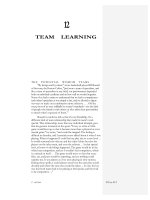group ass eco121 team 3
Bạn đang xem bản rút gọn của tài liệu. Xem và tải ngay bản đầy đủ của tài liệu tại đây (1.68 MB, 20 trang )
<span class="text_page_counter">Trang 1</span><div class="page_container" data-page="1">
<small>(NAMEANDSIGNATURE)</small>
</div><span class="text_page_counter">Trang 2</span><div class="page_container" data-page="2">TABLEOFCONTENT
</div><span class="text_page_counter">Trang 3</span><div class="page_container" data-page="3">TheIndianeconomyisa developingnewindustrial marketeconomy,the sixthlargestintheworld, aftertheUnited States,China,Japan,Germanyand theUnited Kingdom.Thisrapidrate ofeconomicexpansionwillresult inthesizeofIndia's GDP.India willexceedJapan'sGDPby2030,makingitthesecondlargesteconomyintheAsia-Pacificregion.
TheIndianeconomyisdiverseandincludessectorsandsectors:agriculture,handicrafts,textiles,manufacturingandmanyservicessectors.Advancementtoadigitalageandalargepopulationandeducation,fluentEnglishareyoung turningIndiaintoan importantdestinationfor businessoperations(back office)ofglobalcompaniesastheyconductoutsourcingtheircustomerservicesand technicalsupport.Indiaisa majorexporter ofskilledworkers insoftwareand financialservicesandsoftwareengineering.Othersectorssuchasmanufacturing,pharmaceuticals,biotechnology,nanotechnology,telecommunications,shipbuildingandaviationareshowingstrongpotentialandareseeinghigherandhighergrowthrates.
-Indiaisin3rdpositionafterChinaandJapanamongAsianCountries.Indiasharesaround9%ofthetotalofAsia'sGDP (nominal).
-BasedonPPP,India'seconomyin2021isprojectedat10,207billioninternationaldollars,3rdhighestintheworld,behind theUnitedStatesandChina.Indiacontributes7.19%oftheentireworld's GDP(ppp).Indiasharesover16percent ofthetotalofAsia'sGDP (PPP).Thegross domesticproduct(GDP) ofIndiaat purchasingpowerparity (PPP)is3.35 timesof GDPat nominal.
-TheIndianeconomycrossedthe$1billionmarkin2007andthe$2billionmarkin2014innominalterms.In PPPmethods,Indiacrossedtheonebillionmarkin1990.Estimatesbytheworldbankareavailablesince1960whenthecountry'sGDPwas37mnUSD.2002-19isthebestperiodfortheIndianeconomyasIndia's economyhasexpandedby458%in17years.
-The GrossDomesticProduct(GDP) inIndia wasworth3173.40 billionUSdollarsin2021,according toofficialdata fromtheWorld
Bank.
</div><span class="text_page_counter">Trang 4</span><div class="page_container" data-page="4">-TheGrossDomesticProduct(GDP)inIndiaexpanded0.80percentinthefirstquarterof2022overthepreviousquarter, accordingtoOECDestimatesTheGDPvalueofIndiarepresents0.21percentoftheworldeconomy.
-InIndia,thegrowthrateinGDPmeasuresthechangeintheseasonallyadjustedvalueofthegoodsandservicesproducedbytheIndian economyduringthequarter.Indiaistheworld’stenthlargesteconomyandthe secondmostpopulous. Themostimportantandthefastestgrowingsectorof theIndianeconomyisservices. Trade,hotels,transportandcommunication;financing,insurance,realestateandbusinessservicesandcommunity,socialandpersonalservicesaccountformorethan60percentof GDP.Agriculture,forestry and fishingconstitutearound 12percent oftheoutput,butemploysmorethan50 percentofthelabourforce.Manufacturing accountsfor15percentofGDP,constructionforanother8percentandmining,quarrying,electricity,gasandwatersupplyfortheremaining5
-The Indianeconomyexpanded 4.1%year-on-yearinthe firstthree monthsof2022,slightlyhigherthanmarketforecastsof4%,buttheleastinayear, duetorisingOmicroninfections,elevatedenergyprices,andongoingsupplychainconstraints.
</div><span class="text_page_counter">Trang 5</span><div class="page_container" data-page="5">-TheGrossDomesticProductpercapitainIndia waslastrecordedat1817.82USdollarsin2020.TheGDPperCapitainIndiaisequivalentto14percentoftheworld'saverage.
-TheGrossDomesticProductpercapitainIndia waslastrecordedat7333.51USdollarsin2021,whenadjustedbypurchasingpowerparity(PPP).TheGDPperCapita,inIndia,whenadjustedbyPurchasingPowerParityisequivalentto41percentoftheworld's
</div><span class="text_page_counter">Trang 6</span><div class="page_container" data-page="6">TheIndianGovernment’sfavourablepolicyregimeandrobust businessenvironmenthasensuredthatforeigncapitalkeepsflowing intothecountry.TheGovernment hastakenmanyinitiativesinrecentyearssuchasrelaxingFDInormsacrosssectorssuchasdefence,PSUoilrefineries,telecom,powerexchanges,andstockexchanges,amongothers.
AccordingtotheDepartmentforPromotionof IndustryandInternal Trade(DPIIT),FDIequityinflowinIndiastoodatUS$572.81billionbetweenApril2000-December2021,indicatingthatthegovernment'seffortstoimproveeaseofdoingbusinessandrelaxingFDI normshaveyielded results.
-TotalFDIinflowintoIndiainthethirdquarterofFY22stoodatUS$17.93billion,whiletheFDI equityinflowfor thesameperiod stoodat US$12.02billion.DatabetweenApril-December2021indicatesthatthecomputersoftwareandhardwareindustryattractedthehighestFDIequityinflowofUS$10.25billion,followedbytheautomobilesectoratUS$5.96billion,servicessectoratUS$5.35billion,tradingsectoratUS$2.99billion,constructionactivitiesatUS$1.59billion,anddrugsandpharmaceuticalsatUS$1.21billion.
-BetweenApril-December2021,Indiarecordedthehighest FDIequityinflowfromSingapore(US$11.69billion),followedbytheUS(US$7.52billion),Mauritius(US$6.58billion),theCaymanIslands(US$2.74billion),theNetherlands(US$2.66billion),andtheUK(US$ 1.44billion).
Someof therecentinvestmentsand developmentsinthe FDI spaceareas follows:-InJanuary2022,GoogleannouncedaninvestmentofUS$1billioninIndiantelecomcompanyBhartiAirtel,whichincludesanequityinvestment ofUS$700
</div><span class="text_page_counter">Trang 7</span><div class="page_container" data-page="7">millionfora1.28%stakeinthecompany,andUS$300millionforpotentialfutureinvestmentinareas likesmartphoneaccess, networks,and thecloud.-Canada’spensionfundinvestmentboardinvestedRs.1,200crore(US$160.49million)asananchorinvestorintheIPOofmultipleIndiancompanies-One97communication(Paytm), Zomato,FSNE-CommerceVentures(Nykaa),and PBFintech.
-The FDIinIndia’srenewable energysector stoodatUS$ 1.03billion forthefirsthalfofthefinancialyear2021-22.
→IndiaisexpectedtoattractFDIworthUS$120-160billionperyearby2025,according toaCIIandEY report.Intermsofattractiveness,investors ranked India #3;~80%investorshaveplanstoinvestinIndiainthenext2-3years, while~25%reportedinvestmentsworthmorethanUS$500million,theEconomicTimesreported.Further,asperaDeloittereportpublishedinSeptember2021,Indiaremainsanattractivemarketforinternationalinvestorsbothintermsofshort-termandlong-termprospects.Indiaranked43rdontheInstituteforManagementDevelopment’s(IMD)annualWorldCompetitivenessIndex2021.AccordingtotheIMD,India'sdevelopmentsingovernmentefficiencyareprimarilyduetorelativelystablepublicfinances(despiteCOVID-19-inducedchallenges),andoptimisticsentimentsamongIndianbusinessstakeholderswithrespecttothefunding,andsubsidiesofferedbythegovernmenttoprivatefirms.
4. STANDARDOFLIVINGININDIA
-ThestandardoflivinginIndiavariesfromstatetostate.By2021,extremepovertyhasbeencompletelyeliminatedtoaslowas0.8%andIndia isnolongerthecountrywiththelargestpoorpopulation.
-Thereisconsiderable incomeinequalityin India,asitisalso hometosome oftherichestpeopleintheworld.Average wagesareestimatedtoquadruplebetween 2013and2030.
-ThestandardoflivinginIndiaalsoshowslargegeographicaldisparities.Forexample,ontheonehand,mostmetropolitancitiesandothermetropolitanandsuburbanareasboast world-classmedicalfacilities, luxuryhotels,sportsfacilitiesandrecreationalactivities. similartothat infirstworld developedcountries,whilepovertyissignificantin ruralareasofIndia,wheremedicalcaretends tobeverybasicorunavailablebecauseofashortageofdoctors.Similarly,thelatestmachinerycanbeusedinmostconstructionprojects,butsomeconstructionworkersworkwithoutmechanizationonsomeprojects,mostlyinruralareas.However,aruralmiddleclassisnowemerging inIndia, withsomeruralareas increasinglyprosperous.-AccordingtotheIMF'sWorldEconomicOutlookfor2020,India'sPPPadjustedGDPpercapitaisestimatedatUS$9,027.
24.3%ofthe populationearned lessthanUS$1 (PPP,aboutUS$0.25 innominalterms)perdayin2005,downfrom42.1%in1981.41.6%ofthepopulation(about540millionpeople)are livingbelowthe newinternationalpoverty lineof$1.25 perday(PPP)perday,downfrom59.8%in1981.India,in2019hadabout2.7%ofthepopulationbelowthe povertyline andisnolonger thelargest populationbelowthepovertyline
</div><span class="text_page_counter">Trang 8</span><div class="page_container" data-page="8">Sinceindependence,India hasallocatedalmost halfofitstotalfive-yearplantoinfrastructuredevelopment.Mostof thetotal fundingisspentonlarge projectsin thefieldsofirrigation,energy,transportation,communication,andsocialcosts.Infrastructuredevelopmentisentirelyinthehands ofthepublicsectorand ishamperedbycorruption,bureaucraticinefficiencies,urbanbias,andaninabilitytoinvestatscale.Kolkataisthefirst cityinIndiatoboasta metrosystem.Thegovernmenthaspartially openedtheinfrastructuretothe privatesectortoallowforeigninvestment.Indiaholdssecondplaceintheworldintermsofroadconstruction.
Asof2018,thereareanestimated18,170,000broadbandlinesinIndia.Thecountryboaststhesecond-highestnumberofInternet userswith446.75millionpeople,about35%ofthecountry'spopulation.
A2007studybytheAsianDevelopmentBankfoundthatin20cities,theaveragewatersupplytimewasonly4.3hoursperday. Nocityhasaconstantsupplyofwater.Thelongestsupplytimeis12hoursperdayinChandigarhandthelowestis0.3hoursperdayinRajkot.
AstudybyWaterAidestimatesthatupto157millionIndianslivewithoutadequatesanitation.Indiaisatthetopbecauseithasthemostsignificantnumberofurbandwellerslivingin unsanitaryconditions.
</div><span class="text_page_counter">Trang 9</span><div class="page_container" data-page="9">OneofthekeyproblemsfacingtheIndian economyisthewideningdisparity amongIndianstates andterritoriesinterms ofpercapitaincome,poverty,availabilityoffacilities,etc.infrastructure,andsocio-economicdevelopment.Forexample,thedifferenceingrowthratesbetweenforwardandbackwardcountrieswas0.3%(5.2%&4.9%)between1980–81and1990–91,butincreasedto3.3%(6.3%&3.0%)fortheperiod1990–91to1997–98.
Inthepast,Indiahadaperiodoffiscaldeficitformorethan40years. Finallysurplusinthe1970s .
In2003,theFRBM(FiscalResponsibilityandBudgetManagement)actwasenacted,settingthegoalofthegovernmenttoreducethefiscaldeficitto3%ofgrossdomesticproduct(GDP)andkeepthebudget deficitlowforaperiodof time.
butitchangeddrastically afterCOVID-19,thebudgetdeficit increasedsharplyafterthat.
</div><span class="text_page_counter">Trang 10</span><div class="page_container" data-page="10">ThefinanceministryinFebruaryhadestimatedthedeficitatRs15.91,089croreor6.9percentofGDP.However,inrealityintheperiodof2021-2022,thebudgetdeficitinabsolutetermsisRs15,86,537(provisional),ie6.71%ofGDP,whichisconsideredimproved,mainlyduetohigh taximplementation.
AlsoaccordingtotheGeneralControl ofAccounts(CGA)taxrevenuefor thefinancialyearwasRs18.2trillion-comparedwitharevisedestimate(RE)ofRs17.65trillion.
TotalspendingwasalsohigheratRs37.94trillioncomparedto-REofRs37.7trillionpresentedtotheNationalAssemblyon1February2021.Thatmeansrevenuedeficitattheendofthefiscalyearwas 4.37%
Thebudgetdeficitforthefirstmonthof2022-23is4.5%oftheBudgetEstimateforthecurrentfiscal. (Thedeficitwas 5.2%inthe sameperiodlast year.)
Centralgovernmentbudget deficitat theendofMay stoodat 12.3%(Rs2,03,921)mainlyduetohigherspending(Deficitwas8.2%inthesameperiodlastyear)Accordingtothedata,thetotalgovernment incomeattheendofMaywas Rs3.81lakhcroreor16.7%BEfor2022-23. Earningswerearound18%BEfor2021-22overthelastfinancialperiod.
AsofMay,(net)taxrevenuewasat15.9% ofBE2022-23.(Itwas15.1%of 22foraone-yearperiodago.)Real-time,nettaxrevenuestoodatRs3,07,589croreduringApril-May
Thegovernmentprojectsthefiscaldeficit forthecurrentfinancialyearat 6.4%ofGDPorRs16.61trillion.asthereissomerisktotheRs16.6trillionfiscaldeficittargetfor 2022-23,stemming fromrevenueloss forthe Centerdue toexcisetax cuts,under-budgettransfers.surplusofRBIandadditionalspendingneedsforfood,fertilizerandLPGsubsidiesduringtheyear.
Inaddition,the GovernmentinitsrevisedBudget estimatefor2022-23forecasts ahigherfiscaldeficitof6.9%ofGDPorRs 15.91,089forthefiscalyearending March.
NetFPIrecordedanoutflowof$15.2bnmainlyfromequitymarket
</div><span class="text_page_counter">Trang 11</span><div class="page_container" data-page="11">Indiarecordedacurrentaccountdeficit(CAD)of1.2% ofGDPin2021-22 againstasurplusof0.9%in2020-21asthetradedeficitwidenedto$189.5billionfrom$102.2billionayear earlier
Thecurrentaccountbalancerecordedadeficitof1.2%ofGDPin2021-22asagainstasurplusof0.9%in2020-21asthetradedeficitwidenedto$189.5billionfrom$102.2billiona year ago,”the RBIsaidin arelease.
Netinvisiblereceiptswerehigherin2021-22onaccountofanincreaseinnetexportsofservicesandnetprivatetransfer receiptsthoughnetincomeoutgowashigher thanayearago.
Themerchandisetradedeficitnarrowedto$54.5billionintheMarchquartercomparedwitha deficitof$60.4 billionin thepreviousquarter. Thedeficit inthesamequarterayear earlier,however,hadstoodat$41.7billion.
AsperpreliminarydataonIndia’sBoPforthefourthquarter(JanuarytoMarch),currentaccountdeficit(CAD)decreasedto$13.4billion(1.5%ofGDP)inQ42021-22from$22.2 billion(2.6 %ofGDP) inQ3:2021-22.“The sequentialdecline inCAD
</div><span class="text_page_counter">Trang 12</span><div class="page_container" data-page="12">Netservicesreceiptsincreased,bothsequentiallyandonayear-on-year(y-o-y)basis,ontheback ofarise innet earningsfromcomputer andbusinessservices. Privatetransferreceipts,mainlyrepresentingremittancesbyIndiansemployedoverseas,increasedto$23.7billion,upby13.4%fromtheirlevelayearearlier.
Netoutgofromtheprimaryincome account,largelyreflectingnetincomepaymentsonforeigninvestment,decreasedsequentiallyaswellasonay-o-y basis.Inthefinancialaccount,netforeigndirectinvestment(FDI)at$13.8billionwashigherthan$2.7billioninQ42020-21.
Netforeignportfolioinvestmentrecordedanoutflowof$15.2billion–mainlyfromtheequitymarket.NetECBstoIndiawerelowerat$3.3billioninQ42021-22ascomparedwith$6.1billionayear earlier.
Therewasa drawdownof$16 billionintheforeignexchangereserves(on aBoPbasis)asagainstanaccretionof$3.4billioninQ42020-21.
AspertheReserveBank ofIndia(RBI), India’sbankingsector issufficientlycapitalisedandwell-regulated.Thefinancialandeconomicconditionsinthecountryarefarsuperiortoanyothercountryintheworld.Credit,marketandliquidityriskstudies suggestthatIndianbanks aregenerallyresilientand havewithstoodtheglobal downturnwell.
</div><span class="text_page_counter">Trang 13</span><div class="page_container" data-page="13">Thedigitalpaymentssystem inIndiahasevolvedthemostamong25countrieswithIndia’sImmediatePaymentService(IMPS)beingtheonlysystem atlevelfiveintheFasterPaymentsInnovationIndex(FPII).
TheIndianbankingsystem consistsof12publicsectorbanks,22privatesectorbanks,46foreignbanks,56regionalruralbanks,1485urbancooperativebanksand96,000ruralcooperativebanksinadditionto cooperativecreditinstitutionsAsofSeptember2021,thetotalnumberofATMsinIndiareached213,145outofwhich47.5%areinruralandsemiurbanareas.
+InFY18-FY21,bankassetsacross sectorsincreased.Totalassetsacrossthebankingsector(includingpublicandprivatesectorbanks)increasedtoUS$2.48trillioninFY21.
+In FY21,totalassetsin thepublicand privatebankingsectors were US$1,602.65billionandUS$878.56billion,respectively.
+DuringFY16-FY21,bankcreditincreasedat aCAGRof0.29%.Asof FY21,totalcreditextendedsurgedtoUS$1,487.60billion.DuringFY16-FY21,depositsgrewataCAGRof12.38%andreachedUS$2.06trillionbyFY21.BankdepositsstoodatRs.162.41trillion(US$2.17trillion)asofDecember31,2021.
+Accordingto IndiaRatings& Research(Ind-Ra),credit growthisexpectedtohit10%in2022-23whichwillbeadouble-digitgrowthineightyears. AccordingtotheRBI,bankcreditstoodatRs.116.8lakhcrore(US$1.56trillion)on31stDecember2021.
+AsofFebruary2022,credittonon-foodindustriesstoodatRs.114.10trillion(US$1.53trillion).
</div><span class="text_page_counter">Trang 14</span><div class="page_container" data-page="14">+AsofFebruary21,2022,thenumberofbankaccounts—openedunderthegovernment’sflagshipfinancial inclusiondrive‘PradhanMantriJan DhanYojana(PMJDY)’—reached44.63croreanddepositsintheJanDhanbankaccountstotalledRs.1.58trillion(US$21.25billion).
+InOctober2020,HDFCBankandApolloHospitalspartneredtolaunchthe‘HealthyLifeProgramme’,a holistichealthcare solutionthatmakeshealthy livingaccessibleandaffordableonApollo’sdigitalplatform.
+In2019, bankingand financialserviceswitnessed 32M&A(merger and acquisition)activitiesworthUS$1.72billion.
+InMarch2020,StateBankofIndia(SBI),India’slargestlender,raisedUS$100millioningreen bondsthroughprivate placement.
—>Enhancedspendingoninfrastructure,speedyimplementationofprojectsandcontinuationofreforms areexpectedto providefurther impetustogrowth inthebankingsector.AllthesefactorssuggestthatIndia’sbankingsectorispoisedforrobustgrowthasrapidlygrowingbusinesseswillturntobanksfortheircreditneeds.Also,the advancementintechnologyhas broughtmobileand internetbankingservicestothefore.Thebankingsector islayinggreateremphasisonprovidingimprovedservicestotheirclientsandupgradingtheirtechnologyinfrastructuretoenhancecustomer’soverallexperienceaswellasgivebanksacompetitiveedge.
8.FINANCIALMARKET
WhatisIndia's,Financial Market?
Whatdoesthe IndiaFinancialmarketcomprise? Ittalksabout theprimarymarket,FDIs,alternativeinvestmentoptions,banking,insurance,andpensionsectors,andassetmanagementsegment aswell. Withalltheseelements inthe IndiaFinancialmarket,ithappenstobeoneoftheoldestacrosstheglobeandisdefinitelythefastestgrowingandbestamongallthefinancialmarketsoftheemergingeconomies.ThehistoryofIndiancapitalmarketsspansback200years,aroundtheendofthe18thcentury.ItwasatthistimethatIndiawasundertherule oftheEastIndiaCompany.Thecapital marketofIndia initiallydeveloped aroundMumbai; witharound200 to250securitiesbrokersparticipatinginactivetradeduringthesecondhalfofthe19thcentury.
ScopeoftheIndiaFinancialMarket-ThefinancialmarketinIndiaatpresentismoreadvancedthanmanyothersectorsasitbecameorganizedasearlyasthe19thcenturywiththesecuritiesexchangesinMumbai,Ahmedabad,andKolkata.Intheearly1960s,the numberofsecuritiesexchangesinIndiabecameeight-includingMumbai,Ahmedabad,andKolkata.Apartfromthesethree exchanges,thereweretheMadras,Kanpur,Delhi,Bangalore,andPuneexchangesaswell.Todaythereare23regionalsecuritiesexchangesinIndia.TheIndianstockmarketstodatehaveremainedstagnantduetorigideconomiccontrols.Itwas onlyin1991, afterthe liberalizationprocessthat theIndian securitiesmarketwitnessedaflurryofIPOsserially. Themarketsawmanynew companiesspanningdifferentindustrysegmentsandbusinessbegantoflourish.
</div>








